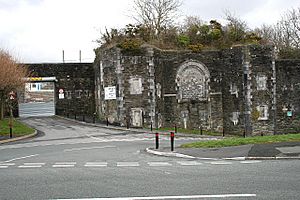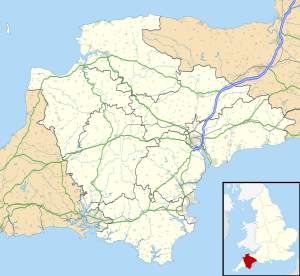Fort Austin facts for kids
Quick facts for kids Fort Austin |
|
|---|---|
| Plymouth Devon England |
|

Entrance to Fort Austin, showing bricked up original entrance on the right
|
|
| Coordinates | 50°23′59″N 4°06′12″W / 50.3997°N 4.1034°W |
| Site information | |
| Owner | Privately owned |
| Controlled by | Plymouth City Council |
| Open to the public |
No |
| Condition | Largely intact with some alterations |
| Site history | |
| Built | 1863-1868 |
| In use | Now a Buddhist Temple |
| Materials | Earth Masonry |
Fort Austin is an old fort built in the 1800s. It was created to protect the city of Plymouth in England. This fort was part of a big plan to defend the important Royal Naval Dockyard at Devonport.
The dockyard was where naval ships were built and repaired. Fort Austin was one of many forts built around the coast of Britain. These forts are often called Palmerston Forts. They were named after the Prime Minister at the time, Lord Palmerston, who strongly supported building them.
Why Was Fort Austin Built?
Fort Austin was built between 1863 and 1868. It was designed by Captain Edmund Frederick Du Cane, who later became a Major General. The fort's main job was to protect Plymouth from attacks coming from the land, especially from the northeast.
The decision to build these forts came from a special group called the Royal Commission on National Defence in 1859. This group looked at how Britain could best defend itself. They decided that new, strong forts were needed to protect important places like naval dockyards.
How Was the Fort Made?
The fort was first built by a company called George Baker and Company. Later, the Royal Engineers finished the construction. The Royal Engineers are a special part of the British Army. They are experts in building and engineering.
Fort Austin was armed with fifteen large guns and five mortars. Mortars are a type of cannon that fires shells high into the air. These weapons were placed to defend against any invading forces.
To house the soldiers who would defend the fort, a special building was constructed inside. This barrack block could hold up to 60 men. It provided living quarters for the soldiers stationed there.
What Happened to Fort Austin?
By the early 1900s, Fort Austin was no longer needed for defence. Military technology had changed a lot, and the fort became old-fashioned. Because of this, its guns were removed, and it was no longer used as a military defence point.
During the Second World War, the fort found a new purpose. It was used by a secret group called the Devon and Cornwall Auxiliary Unit. This unit was made up of volunteers who would have fought behind enemy lines if Britain had been invaded.
In 1958, the War Office, which managed military property, sold Fort Austin. It was bought by the Plymouth City Council. The fort was recognized as an important historical building in 2008. It was given a "Grade II listed" status, which means it is protected for its special historical or architectural interest.
Today, Fort Austin is used as a depot by the Plymouth City Council. A depot is a place where equipment and supplies are stored.


